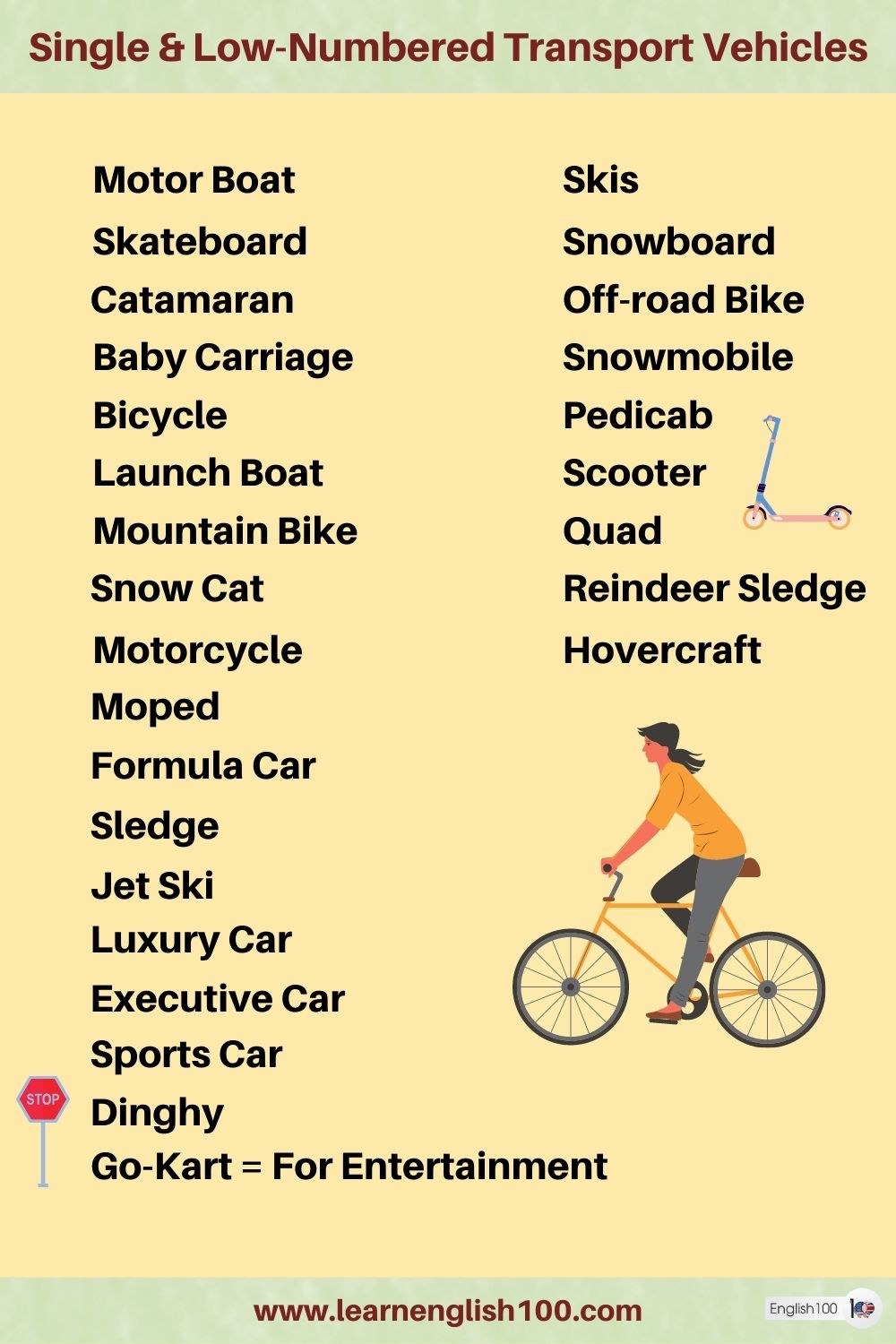
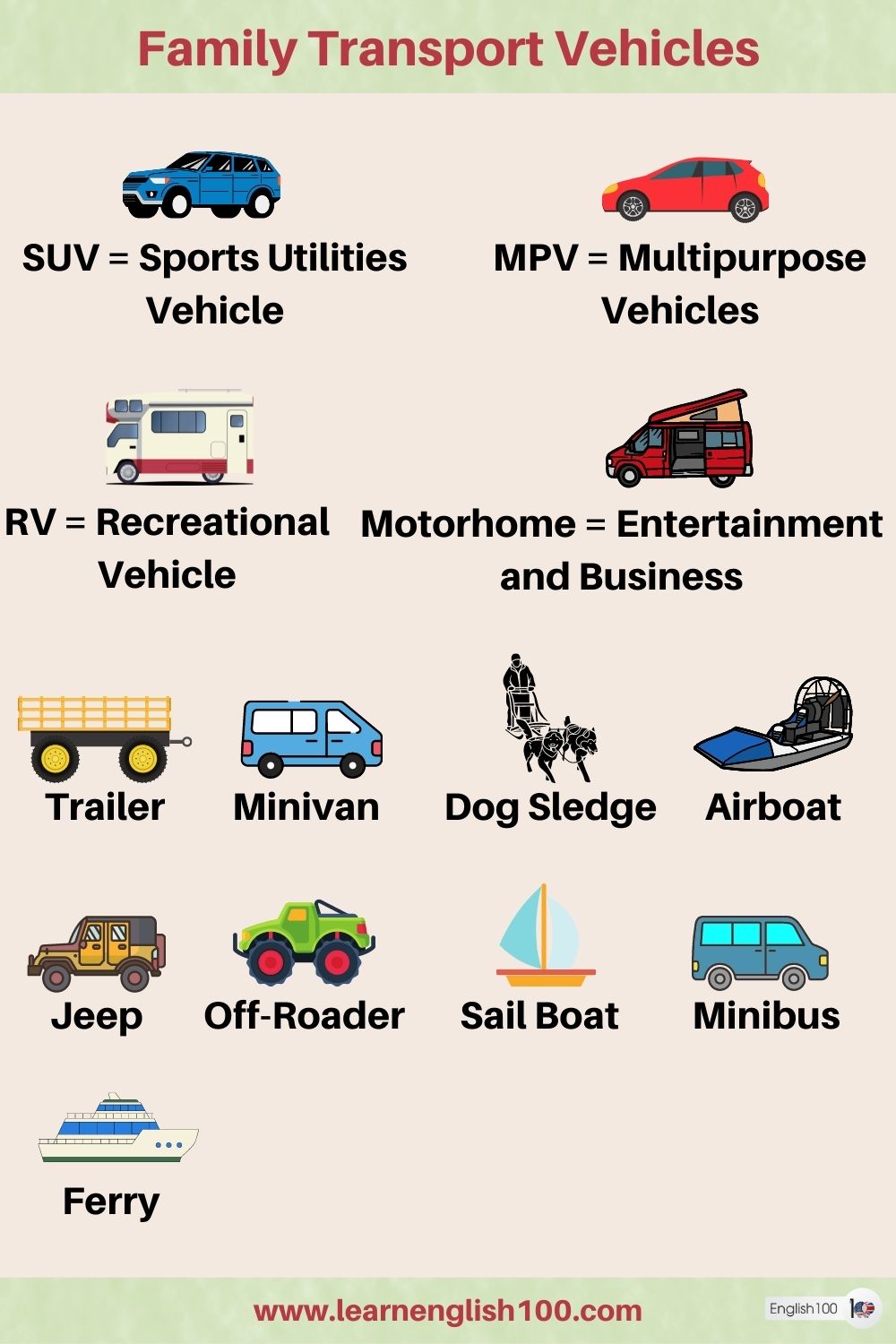
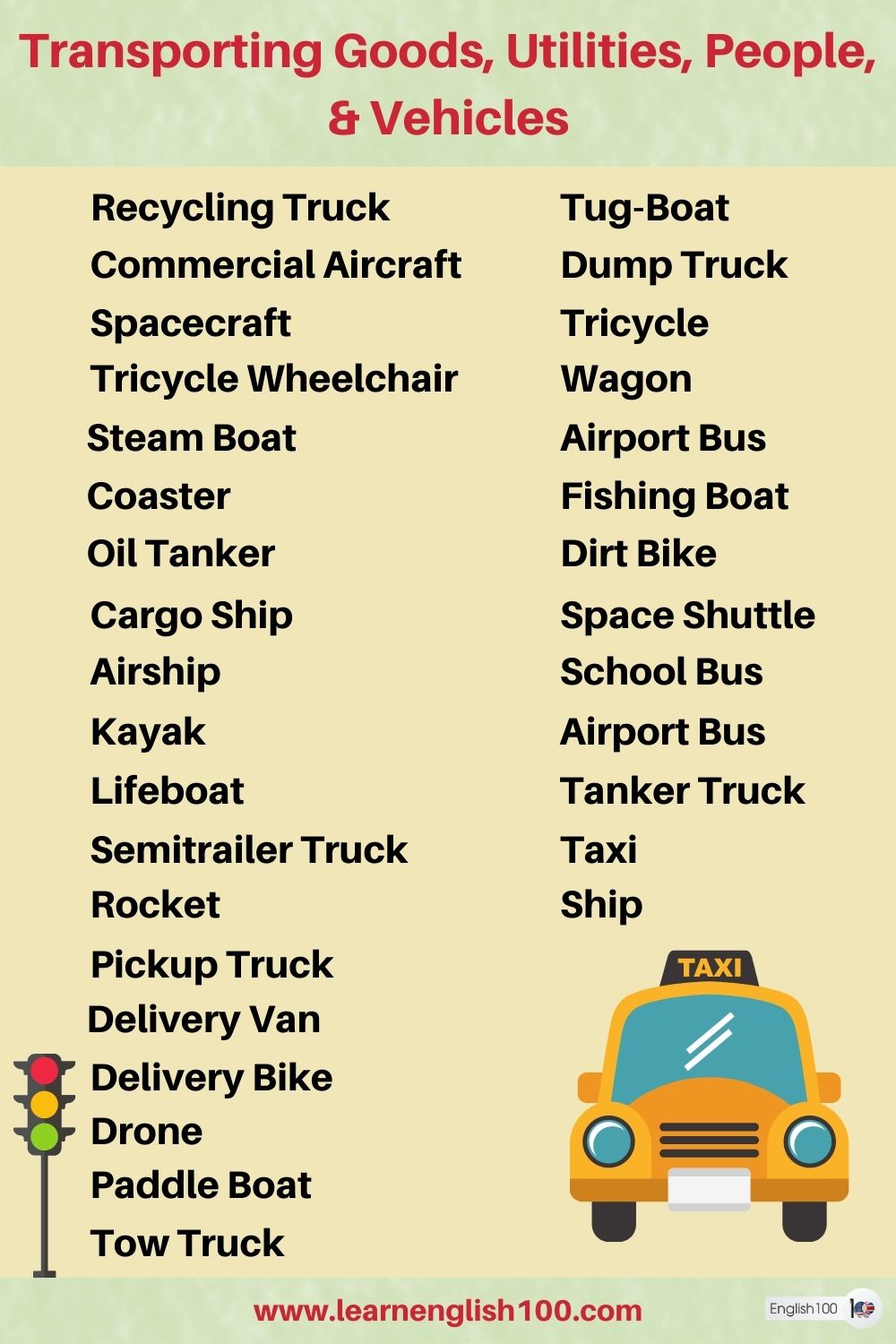
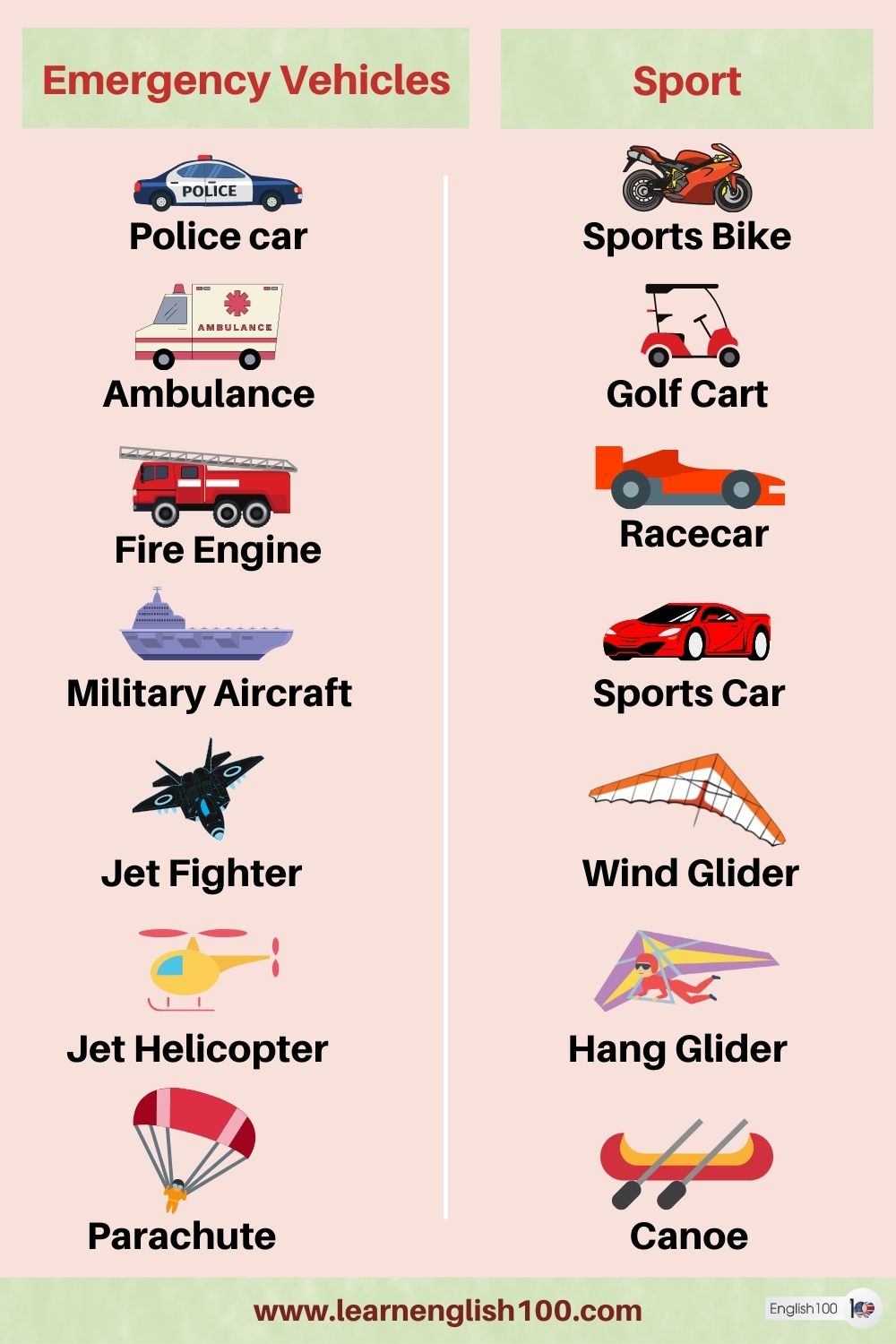
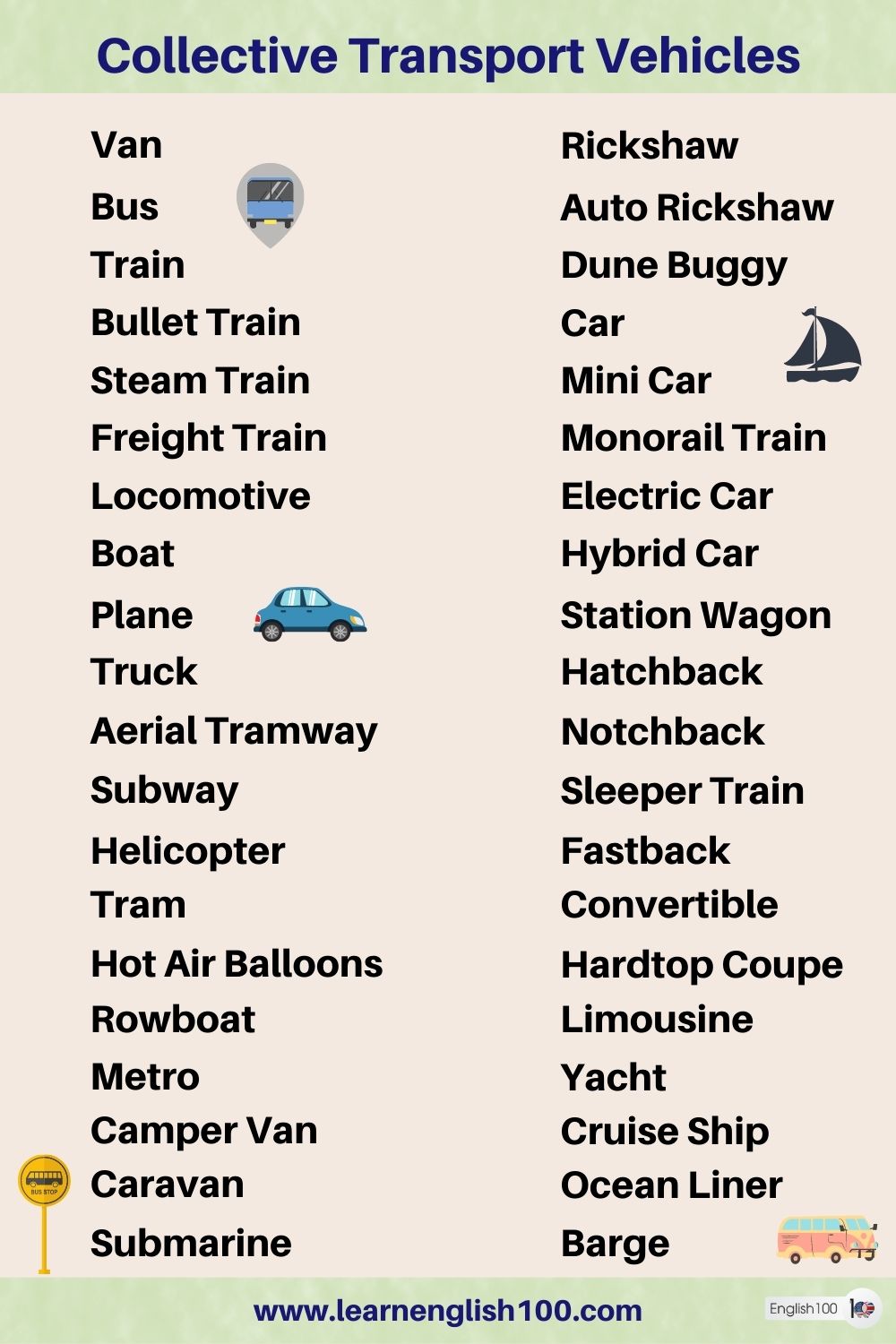
Transport Vehicles’ Names and Types
In our fast-paced world, transportation is a vital component of daily life. Transport vehicles come in a wide array of shapes and sizes, each designed to serve specific purposes efficiently. From personal commuting to the movement of goods and people on a larger scale, understanding the various types and names of transport vehicles is essential. In this article, we will delve into the diverse world of transport vehicles, exploring their types, names, and the roles they play in keeping our world connected.
Now, let’s explore the world of Transport!
Collective Transport Vehicles
Van
Bus
Train
Bullet Train
Steam Train
Freight Train
Locomotive
Boat
Plane
Truck
Aerial Tramway
Subway
Helicopter
Tram
Hot Air Balloons – Entertainment and Science Experiments
Rowboat
Metro
Camper Van
Caravan
Rickshaw
Auto Rickshaw
Dune Buggy
Car
Mini Car
Monorail Train
Electric Car
Hybrid Car
Station Wagon
Hatchback = Liftback
Notchback
Sleeper Train
Fastback
Convertible
Hardtop Coupe
Limousine = Town Car
Double Decker Bus
Yacht
Cruise Ship
Ocean Liner
Barge
Aircraft Carrier
Submarine
Snow Bombardier
Single & Low-Numbered Transport Vehicles
Motor Boat = Power Boat
Skateboard
Catamaran
Baby Carriage
Bicycle
Launch Boat
Mountain Bike
Scooter
Motorcycle
Moped
Formula Car
Sledge
Jet Ski = Personal Water Craft = PWC = Water Scooter
Luxury Car
Executive Car
Sports Car
Dinghy
Go-Kart = For Entertainment
Hovercraft
Reindeer Sledge
Skis
Snowboard
Off-road Bike
Snowmobile
Pedicab
Snow Cat
Quad
Family Transport Vehicles
SUV = Sports Utilities Vehicle
MPV = Multipurpose Vehicles
RV = Recreational Vehicle
Jeep
Minivan
Trailer
Dog Sledge
Motorhome = Entertainment and Business
Off-Roader
Sail Boat
Minibus
Coach
Ferry
Airboat
Transport Vehicles that serve other purposes
Special Purposes: (Excavator = Archaeology) – (Snow Plow = Clearing Roads)
Farming: Tractor – Bullock Cart – Donkey Cart – Camel Cart – Riding Lawnmower – Trolly
Building: Crane – Forklift – Cement Mixer – Bulldozer – Wheelbarrow – Backhoe – Road Roller
Transporting Goods, Utilities, People, & Vehicles
Recycling Truck
Dump Truck
Spacecraft
Wagon
Steam Boat
Coaster
Oil Tanker
Cargo Ship
Airship
Kayak
Lifeboat
Taxi
Rocket – To transport Supplies to Space / Spacecraft
Pickup Truck
Delivery Van
Delivery Bike
Drone
Paddle Boat
Tow Truck
Tug-Boat
Commercial Aircraft
Tricycle
Tricycle Wheelchair
Airport Bus
Fishing Boat
Dirt Bike
Space Shuttle
School Bus
Airport Bus
Tanker Truck
Semitrailer Truck
Ship
Emergency Vehicles
Police car
Ambulance
Fire Engine = Fire Truck
Military Aircraft
Jet Fighter
Jet Helicopter
Parachute
Manlift
Sport
Sports Bike
Golf Cart
Racecar
Sports Car
Wind Glider
Hang Glider
Parachute
Canoe
Speed Boat
Formula Car
A lot of words in English have a stigma. Now those stigmas may stem from a real issue related to the words themselves, but other times those stigmas are just mere rumors about these words. They are simply myths that got stuck in the back of peoples’ minds without being checked, critiqued, or even simply questioned rationally.
For example, from road vehicles, there are the words unmarked van. No news outlet has ever used the words unmarked van for any positive mention whatsoever.
Here’s a fun list of examples including the words unmarked van:
A man in an unmarked van contributed a large sum of money to a charity that cares for puppies.
I saw an adorable golden retriever in an unmarked van the other day.
Two women stepped out of an unmarked van rushing to the hospital to save a dog and a cat that was caused by a drunk driver.
A group of philanthropists is touring the country now in an unmarked van to help whomever they can.
The police cleared the way for an unmarked van to rescue the injured people from the crash since police vehicles were unfortunately low on gas.
A home invader was luckily stopped by an unmarked van with no injuries at all after fleeing the scene of the crime on a motor vehicle.
Now as you can see the types of vehicles do not define what is happening in those vehicles or as the saying goes, don’t judge a book by its cover.
Now, let’s dive into the rest of the vehicle names and use them in meaningful sentences:
Formula cars need constant development and testing in order to improve their performance and agility.
There are very few and extremely precious seconds in every formula-car race.
These priceless seconds decide who dominates the world of speed in every formula-car race.
A golf cart may seem boring, but its vital role in the game makes it irreplaceable.
Parachutes and Wind Gliders are two unique ways to enjoy the mountains.
Being in a jet fighter was the most exhilarating thing I have ever experienced.
We, as a society, do not credit the workers of dump trucks enough.
The drivers of emergency vehicles such as ambulances and fire engines are saving lives just as well as the rescuers.
Teenagers specifically need to work on a delivery bike or a delivery van so they can truly appreciate what is being provided for them.
Taxis have become a part of the old culture that we need to appreciate as well.
The role of tractors is indispensable in some countries, but we must keep grinding to find new vehicles that are more environmentally friendly.
Many residents in my neighborhood did not appreciate the work of a road roller until our street became a flat mess.
Depending on their structure, trucks can be rigid, articulated, road train and mega-trucks. Thus, depending on the type of goods they transport, we can speak of canvas trucks, open platform trucks, refrigerated trucks, heat trucks, tank trucks, closed trucks, car carriers and cage trucks. 1
FAQ
What is the name of vehicles?
Vehicles encompass a broad category of transportation equipment designed for moving people or goods. Here are some common names of vehicles based on their types:
1. Personal Transport Vehicles:
Automobiles (e.g., cars, trucks)
Motorcycles and scooters
Bicycles
Electric scooters (e-scooters)
2. Public Transport Vehicles:
Buses (e.g., city buses, coach buses)
Trains (e.g., commuter trains, subways, light rail)
Trams and streetcars
Ferries and water taxis
3. Commercial and Freight Transport Vehicles:
Trucks (e.g., pickup trucks, delivery trucks, semi-trucks)
Cargo vans
Shipping containers
Freight trains
4. Specialized Transport Vehicles:
Emergency vehicles (e.g., ambulances, fire trucks, police cars)
Recreational vehicles (RVs)
Construction and heavy equipment (e.g., bulldozers, excavators, cranes)
5. Air and Water Transport Vehicles:
Airplanes (e.g., commercial airliners, private jets)
Helicopters
Boats (e.g., sailboats, speedboats)
Ships (e.g., cargo ships, cruise ships)
6. Recreational and Sport Vehicles:
All-terrain vehicles (ATVs)
Jet skis and personal watercraft (PWC)
Snowmobiles
Golf carts
7. Electric and Alternative Fuel Vehicles:
Electric cars
Hybrid vehicles
Hydrogen fuel cell vehicles
8. Spacecraft and Exploration Vehicles:
Space shuttles
Mars rovers
Satellites
What is the most used vehicle for transportation?
The most used vehicle for transportation worldwide is the automobile, commonly referred to as a “car.” Cars are incredibly popular for personal transportation due to their convenience, versatility, and widespread availability. They are used by individuals and families for daily commuting, running errands, and leisure activities.
Key reasons why cars are the most commonly used vehicles for transportation include:
Accessibility: Cars are widely accessible and can be owned or rented by individuals. They are available in various price ranges, making them accessible to a broad spectrum of people.
Convenience: Cars provide door-to-door transportation, allowing people to travel directly from their origin to their destination without the need for transfers or waiting for public transportation.
Flexibility: Car owners have the flexibility to choose their routes, schedules, and destinations, giving them greater control over their transportation.
Comfort: Cars offer a comfortable and climate-controlled environment, making them suitable for various weather conditions.
Cargo Capacity: Cars can transport passengers and goods simultaneously, making them versatile for various purposes, including shopping, moving, and family outings.
Privacy: Cars offer privacy during travel, which can be important for personal or business matters.
Long-Distance Travel: Cars are suitable for both short trips within a city and long-distance travel between cities and regions.
Accessibility to Remote Areas: In many regions, cars provide access to remote or less-served areas where public transportation options may be limited.
To conclude, the world of transport vehicles is diverse and ever-evolving, with each type serving unique purposes in our daily lives. Whether it’s getting from point A to B, transporting goods across the country, or responding to emergencies, the array of transport vehicles ensures that our modern world remains connected and functional. Understanding their names and types empowers us to make informed choices about the most suitable vehicles for our needs and contribute to the efficiency of transportation systems.
References:
- Cervera, E., Cervera, E., & Cervera, E. (2023, July 6). Vehicles in the transport of goods. AC Monedero -.
